Once upon a time, a knight called Raymondin, who had been responsible for the death in a hunting accident of his uncle, Count Aymon of Poitou, was wandering alone, a disconsolate outlaw, through the forest of Coulombiers. Coming in the middle of the night upon a magical fountain, he encountered the beautiful Mélusine and her attendants. Mélusine promised that all would be well if he married her, and that they would found a great dynasty. A single condition was imposed: that he must never attempt to enter her chamber on a Saturday.
With Mélusine’s help, Raymondin raised the magnificent castle of Lusignan in only fifteen days. It perched on a steep, narrow promontory of great strategic significance, guarding the marches between Poitou and France. They settled there happily, and she bore him bore ten fine sons.
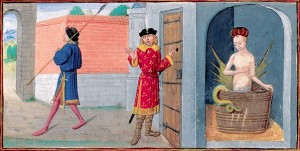
Raymondin discovers Mélusine's secret by peeping through a hole in the door: from a late-fifteenth-century edition of Jehan d'Arras's 'Le Roman de Mélusine' in the Bibliothèque nationale de France
One Saturday, however, Raymondin’s jealous brother persuaded him to spy on her, hinting that she might be seeing another man. Mélusine was innocently bathing, but, to Raymondin’s horror, her lower half had been transformed into that of a serpent or fish. With an anguished cry she assumed a different form, that of a dragon, and flew out of the window, never to return.
The fairy Mélusine was nevertheless to be proudly claimed as their ancestress by the later lords of Lusignan. Her line included the crusader kings of Jerusalem, Cyprus and Armenia, and the four sons of Hugh de Lusignan, Count of the March, by Isabella of Angoulême, the widow of King John of England. The favourites of their half-brother, Henry III, the Lusignan brothers – William, Aymer, Guy and Geoffrey – were hated by the English and expelled from the kingdom in the rebellion of 1258, having encouraged Henry in the belief ‘that a prince is not subject to law, and so justice itself was banished beyond the boundaries of the realm’ (Annales Monastici, Rolls Series 36, I, pp.463-4, cited in Clanchy, England and its Rulers, London, 1983, p.222).
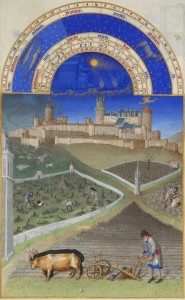
The town and castle of Lusignan, the favourite residence of Jean, Duc de Berry, depicted in his 'Très Riches Heures' in the calendar entry for March. Mélusine, in the form of a dragon, hovers over the tower that bears her name
The direct line of the Lusignans expired in 1314 with the lady Yolande, who in 1308 had sold her estates to King Philip IV of France. It was thus as a part of the royal demesne that Lusignan was acquired by Jean, Duc de Berry, to whom the Limbourg brothers dedicated their Très Riches Heures (c.1412 – 16), the finest surviving specimen of French gothic manuscript illumination. In a famous depiction in the manuscript of Lusignan, which had become the duke’s favourite residence, Mélusine in the form of a dragon can be seen to hover over the tower that still bore her name, within which the spring that was sacred to her still flowed. Meanwhile, Duke Jean’s secretary, Jehan d’Arras, had been entranced by the ‘spinning yarns’ of the local women, which had inspired his Roman de Mélusine (c.1382 – 94), the earliest literary version of the legend.
According to an entry in La Chronique de Saint-Maixent, the castle was actually built in the mid-tenth century by Hugh II ‘the Kind’, Lord of Lusignan, no doubt on the site of a Roman oppidum. Naming their town after their general, ‘Lucinius’ or Licinius, the Roman colonisers had adopted the tutelary fairy of the spring and had called her mater Lucinia, ‘mother of Lucinia’, as a nod to their chief, Gallo-Roman divinities being invariably called ‘Mother’. The medieval lords of Lusignan had in turn adopted the cult of the fairy who reigned on the rock where they had built their castle (Léo Desaivre, Mère Lusine ou Mélusine dans la littérature et les traditions populaires, Arbre d’Or, Geneva, 2004, pp.18-19).
Catherine de’ Medici, Queen of France from 1547 to 1559, visited Lusignan and was fascinated by its myths, quizzing the elderly local women as they came to do their washing at the spring. They swore to her that Mélusine was often to be seen there, still beautiful in her widow’s weeds, majestically gliding along the pathways or furtively bathing. If one were only able to catch sight of her of a Saturday, one would see her serpent’s tail.
The castle played an important role in the Wars of Religion and was besieged in 1574, after which it was largely demolished, but the legend endures at Lusignan, whose inhabitants are called Merlusins, and where special cakes called ‘Mère Lusines’ are, or used to be made. The town is certainly still known for a type of confectionary called ‘Raymondins’ (Desaivre, p.51; https://fr.wikipedia.org/wiki/Lusignan_(Vienne)#Sp.C3.A9cialit.C3.A9s_culinaires.)
It would be appropriate if such cakes were to be sold at Starbucks, the American coffee-house chain, founded as a single store in Seattle in 1971 but now with 22,551 outlets in 65 countries, which – unwittingly, it seems – has adopted a representation of Mélusine as its logo.
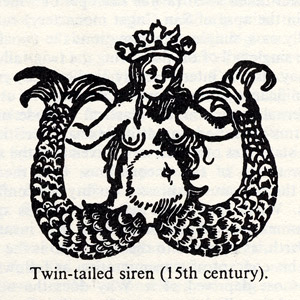
Woodcut illustration of Mélusine from 'Das Buch von einer Frawen genant Melusina' (1480), reproduced in Cirlot's 'Dictionary of Symbols' (1971 - the year that Starbucks was founded)
The company’s earliest design of a crowned, bare-breasted mermaid with two tails has been ingeniously traced to a woodcut in Das Buch von einer Frawen genant Melusina. This is a translation of Jehan d’Arras’s Roman de Mélusine that was printed in Augsburg in 1480. ‘When we were originally looking for a logo for Starbucks in 1971’ – reads the official version – ‘we wanted to capture the seafaring tradition of early coffee traders.’ To this end, one of the founders ‘pored over old marine books until he came up with a logo based on an old sixteenth-century Norse woodcut’.
In fact, there is no such thing as a ‘Norse’ woodcut from that period. It seems more likely that he had lighted upon J.E. Cirlot’s Dictionary of Symbols (English edition, 1971), in which the German woodcut is reproduced. It is almost identical to the prototype design for Starbucks. See http://www.gotmedieval.com/2010/08/the-other-starbucks-mermaid-cover-up.html.
It is thrilling to discover that an ancient legend, the inspiration for artists over the centuries, has such currency and prominence in the modern world. Mélusine is not a nautical mermaid, but is associated with an inland spring, so for Starbucks to acknowledge her now would be to spoil their own ‘founding myth’.

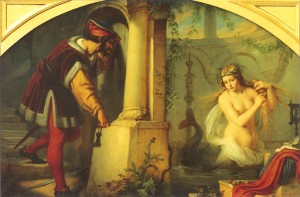
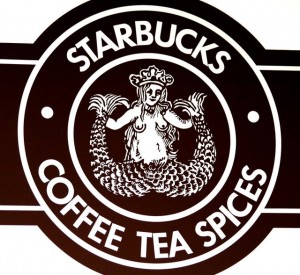
Trackbacks /
Pingbacks